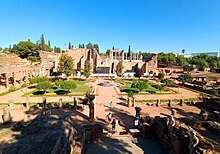Roman Theatre (Mérida)
Teatro Romano de Mérida | |
 | |
| Location | Mérida (Badajoz), Spain |
|---|---|
| Coordinates | 38°54′55.4″N 6°20′18.6″W / 38.915389°N 6.338500°W |
| Type | Roman theatre |
Europe and North America | |
| Official name | Teatro Romano |
| Type | Non-movable |
| Criteria | Monument |
| Designated | 13 December 1912 |
| Reference no. | RI-51-0000107 |
The Roman Theatre of Mérida is a construction promoted by the consul
). It was constructed in the years 16 to 15 BCE. One of the most famous and visited landmarks in Spain, the Roman Theatre of Mérida is regarded as a Spanish cultural icon and was chosen as one of the 12 Treasures of Spain.The theatre has undergone several renovations, notably at the end of the 1st century or early 2nd century CE (possibly during the reign of Emperor
It was built as part of an entertainment complex together with the
Enclave

The theatre is located in the
Structure
Constructed in faithful accordance to the rules of the treatises of
.Stands and orchestra
The semicircular shape of the grandstands cavea is incorporated into the gradient of San Albin hill. In its time it had a seating capacity of 6,000. The diameter is about 86 meters (282 feet). The stands are divided into three areas: the innermost ima cavea, (22 rows) media cavea (5 rows) and summa cavea, the latter being severely deteriorated today. The first rows ima cavea, where the wealthier social classes were seated, is divided into five radial sectors cunei, delimited stairs, a horizontal level, and a corridor praecinctio that separates it from the upper bleachers. Six doors at the top give access to a corridor covered by a semicircular dome ring that serve as entry and exit doors at the two extremities. The middle and upper caveas have five rows of seats each and are supported by a complex system of arches and
The orchestra is a semicircular space paved with white and blue marble intended for the chorus. It is surrounded by three tiers of honour for authorities and separated from the stands by a marble parapet, of which fragments remain. In the front there is a low wall with alternating straight and curved sections and separated from the stage.
Stage

The leading edge of the stage
Peristyle

Behind the stage is a garden area surrounded by columns and a quadrangular
Excavation and restoration

Until the late 19th century, the only visible remains of the theater were the so-called "Seven Chairs", remains of the tops of the bleachers and a formed concrete base covered with granite blocks that made up the
The excavated theater was first used to stage a production in 1933.[2]
In the 1960s and 1970s the front stage was rebuilt under the direction of the architect and archaeologist José Menéndez Pidal y Álvarez.
Current use
Besides being the most visited monument in the city, it has been home to the development of the Festival de Mérida (Festival of Classical Theatre of Mérida) since 1933. The Mérida Classical Theatre Festival is the oldest of its kind celebrated in Spain.
See also
- Archaeological Ensemble of Mérida
- List of Roman sites in Spain
- List of Roman theatres
References
- ISBN 978-0-203-50801-5. Retrieved Sep 27, 2019.
- ISBN 0-7190-5975-5.
External links
- The museum where the original statues are housed http://museoarteromano.mcu.es/index_en.html
- Reconstruction criteria of archaeologist José Menéndez Pidal y Álvarez http://institucional.us.es/revistas/arte/25/vol_II/art_15.pdf
- Mérida Classical Theatre Festival information in English http://marcaespana.es/en/educacion-cultura-sociedad/cine-artes-escenicas/destacados/73/merida-classical-theatre-festival
- Official website of the Mérida Classical Theatre Festival http://www.festivaldemerida.es/
